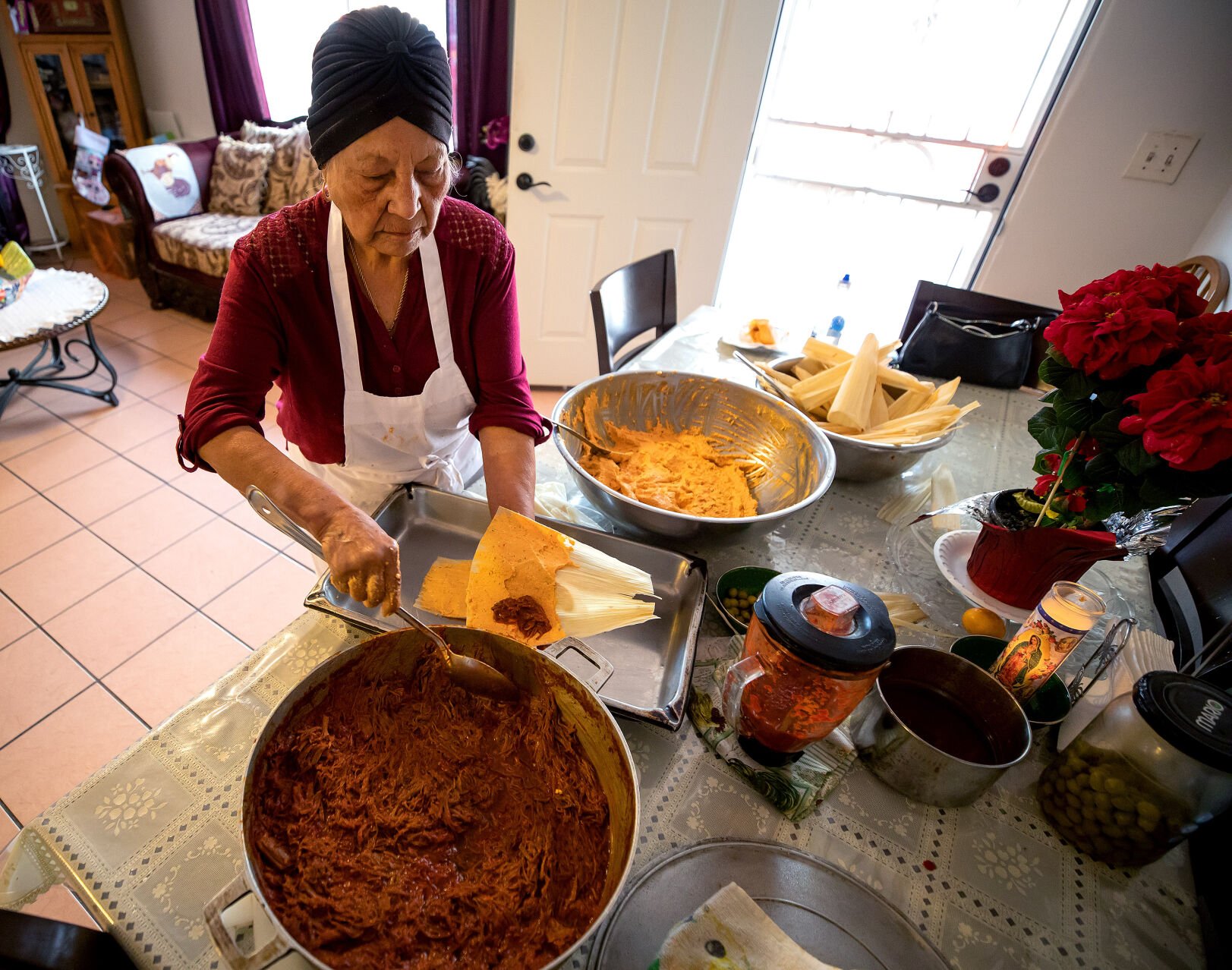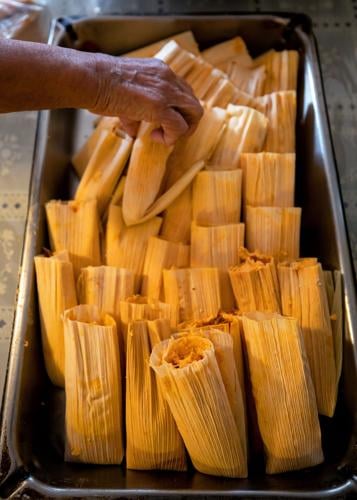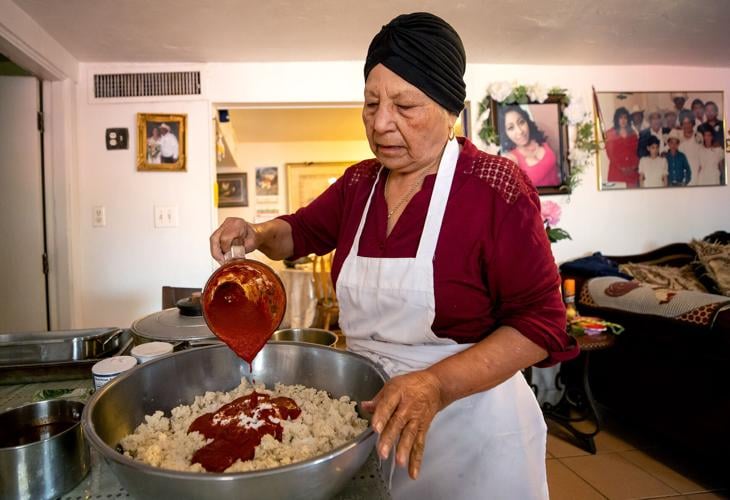Editor's note: This story was originally published in 2021.
Tamales are difficult to make. It’s part of why they feel so special around the holidays. Each component takes time: prepping the red chile beef, making the masa, assembling, and steaming can easily add to a full day, pour into the next. Spreading the masa and folding the corn husks require fine motor skills most of us don’t practice regularly.
So any guide that tells you how to make tamales is going to be inadequate in that way: nothing will teach you how to hold the corn husk to spread the masa evenly better than practice.
I can tell you how I saw Matilde Santa Cruz pinch the corn husk with her thumb on the narrow end and her fingers flat against the wide open tongue that will soon transform into a tamale.

Photos of Matilde Santa Cruz's family are placed on the wall while she makes traditional red tamales at her home in Tucson, Ariz. on Dec. 7, 2021.
She puts a dollop of masa in the center of the husk and flattens her hand as she spreads the masa evenly in each direction. She shifts her grip slightly and the corn husk bends off the edge of her hand, sticky masa abiding by the husk, as she spreads the masa down to her wrist. I can tell you this and it won’t help, not really.
Matilde, who has also made tortillas for nearly two decades at Tucson Meet Yourself, learned these techniques over 74 years of making tamales. She recognizes recipes for masa on sight. When you cut the masa with maseca (corn meal), the tamale comes out too even and mealy. When you don’t add enough lard, the tamale will stick to its wrapper after it’s boiled. (She recommends steaming a couple practice tamales without filling to test the lard-to-masa ratio before you assemble dozens of duds.)
So when I tell you how to make tamales for your Christmas dinner, know that the best way is to find a friend like Matilde to teach you. Watching her, trying and failing under her tutelage, is the only way to really get better. It’s the nature of a tradition to be passed down between people, in person, in a kitchen or across a table. But this article is a starting place.
And if nothing else works, I’ll let you know where to buy the good ones.
Equipment:
- Big, shallow bowl — for mixing the masa
- Cast iron (or heavy-bottomed) pot — for cooking the red chile beef
- Blender — for the red chile sauce
- Pot with a steamer — for cooking the tamales
- Corn husks
- Optional: Tray to hold the folded tamales, and plenty of pots for the jugo de carne and other various ingredients
- Scale to measure the ratios of ingredients
Ingredients and ratio:
The big three ingredients are masa, lard and beef. The masa and lard will make the base of the tamale dough, in a ratio of 5 pounds masa to 1 pound lard. The beef will make the filling, and should weigh 5 pounds before it gets cooked to every 5 pounds masa. Matilde uses 12 pounds of masa to make 8 dozen tamales, which means the base 5:1:5 ratio will make three dozen, give or take a few.

Matilde Santa Cruz finishes making eight dozen traditional red tamales at her home in Tucson, Ariz. on Dec. 7, 2021.
You’ll also need:
- Olives
- Salt
- Baking powder
- Red chile pods
- Onion
- Garlic
- Flour
Pro tips:
- Get your meat at a carniceria and ask for “tamale beef” — the person at the butcher counter will know what you’re looking for. You can also mix pork and beef for extra flavor.
- Buy olives and lard in advance of the holidays, when everyone will be looking for the same ingredients in limited qualities.
Step 1
Make the beef. Boil it until tender, then shred by hand. Save the broth, which you’ll use in the masa.
Step 2
Make the red chile sauce. Boil the dried red chile, then blend it with the water you boiled them in. This might be thin, so make a roux out of lard and flour. Then add the blended chile and cook until it’s the right thickness. Matilde’s would be almost difficult to drink through a straw.
Step 3
Set aside some of the red chile for the masa. Add the rest to the shredded beef along with some of the stock from step 1, and cook until the beef absorbs the flavor of the chile.

Matilde Santa Cruz pours chile sauce to the masa before making traditional red tamales at her home in Tucson, Ariz. on Dec. 7, 2021.
Step 4
Mix the dough: Cook down the lard until it’s liquid, and add to the masa along with some of the red chile, a couple spoonfuls of salt and a little baking powder (Matilde added two heaping tablespoons of salt and one heaping tablespoon of baking powder to 12 pounds of masa, so roughly cut that in half for 5 pounds.) Better to add too little than too much.
Pour in some of the jugo de carne for flavor and consistency. Mix with your hands until the red chile has evenly distributed to make an evenly orange paste. Make sure to get the bits of masa that are sticking to the bottom of the bowl.
Step 5
Make a couple sample tamales to test your masa ratios. Spread the masa into a corn husk and fold (do NOT add filling) and steam for 10 minutes. The tamale should easily come out of its wrapper. If it doesn’t, add more lard. Add salt to taste.

A Tucson home cook spreads masa on a corn husk while making traditional red tamales.
Step 6
Assemble the tamales: first spread the masa thinly and evenly over the corn husk. Then place a shallow ladleful (about half a fist) of meat on the far left side. Place an olive of your preference in the middle. Fold in two-and-a-half finger intervals, tucking the right side over to seal the package.
Pro tip: If you’re having trouble spreading the masa against the corn husk in your hand, start by holding the corn husk flat against the table and spreading the masa there.
Step 7
Steam the tamales in a big pot: 12 tamales should cook for 45 minutes on a medium-low setting so they cook evenly. A three-dozen size pot cooks for an hour and a half.
Step 8
Eat fresh or freeze for up to a year to enjoy later.
Where to find tamales in Tucson:
The best tamales are often part of an informal economy, sold in parking lots or on Facebook Marketplace. This Reddit thread — recommended by #This member, Amber — helped me navigate the tamale scene in Tucson.
If you’d like to order your tamales from a restaurant, local favorites include Perfecto’s, El Torero, St. Mary’s Mexican Food and Tania’s. Check out carnicerias, too: Beef Master, Carniceria El Herradero (the one on St. Mary’s), or Aguajito all get recommendations. Find even more spots to get tamales here.








